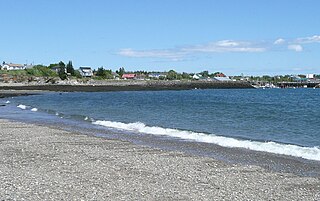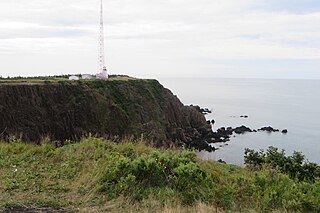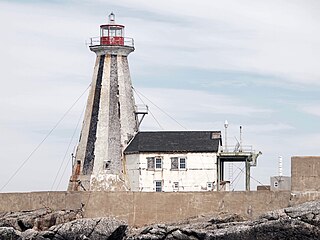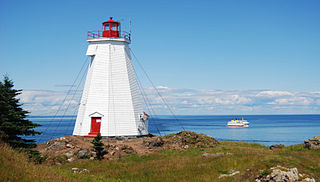
The Bay of Fundy is a bay between the Canadian provinces of New Brunswick and Nova Scotia, with a small portion touching the U.S. state of Maine. Its extremely high tidal range is the highest in the world. The name is likely a corruption of the French word fendu, meaning 'split'.

Grand Manan is a Canadian island in the Bay of Fundy. Grand Manan is also the name of an incorporated village, which includes the main island and all of its adjacent islands, except White Head Island. It is governed as a village and is part of the province of New Brunswick.

Machias Seal Island is an island in disputed water between the Gulf of Maine and the Bay of Fundy, about 16 km (10 mi) southeast from Cutler, Maine, and 19 km (12 mi) southwest of Grand Manan Island, New Brunswick. Sovereignty of the island is disputed by the United States and Canada. The Canadian Coast Guard continues to staff a lighthouse on the island; the first lighthouse was constructed there in 1832.

Point Iroquois Light is a lighthouse on a Chippewa County bluff in the U.S. state of Michigan. Point Iroquois and its light mark the division line between Whitefish Bay and the western end of the St. Marys River, the connection between Lake Superior and other Great Lakes.

White Head Island is an island located in the Bay of Fundy. It is off the east coast of Grand Manan Island, New Brunswick. In 2011 the island had a population of 162. White Head Island is governed as a local service district.
Fundy Cable was a Canadian cable television provider, which served all major New Brunswick communities except for the Sackville area at the time of its purchase by Shaw Communications in 1999. Its operations were later acquired by Rogers Cable.

East Brother Island Lighthouse is a lighthouse located on East Brother Island in San Rafael Bay, near the tip of Point San Pablo in Richmond, California. It marks the entrance to San Pablo Bay from San Francisco Bay.

South Foreland Lighthouse is a Victorian lighthouse on the South Foreland in St. Margaret's Bay, Dover, Kent, England, used to warn ships approaching the nearby Goodwin Sands. Built in 1843, it went out of service in 1988 and is currently owned by the National Trust. It is notable as having been the first lighthouse to use an electric light, and was the site chosen by Guglielmo Marconi for his pioneering experiments in wireless radio transmissions.

The Big Bay Point Light is a lighthouse which stands on a tall bluff over a rocky point near Big Bay, Michigan, approximately 24 miles (39 km) northwest of Marquette on the Upper Peninsula of Michigan. Today it is the only operational lighthouse with a bed and breakfast. It is reputed to be haunted.

Lime Point Lighthouse is a lighthouse in California, on the northern side of the narrowest part of Golden Gate strait. The lighthouse sits at the base of a steep cliff, very near the North anchorage of the Golden Gate Bridge. It is built on a 100-foot (30 m) long rock spur named Lime Point.

Southern Head is a headland located at the southwestern tip of Grand Manan Island in the Canadian province of New Brunswick.
Point Lepreau is a cape in southwestern New Brunswick, Canada.
The history of lighthouses in Canada dates back to 1734.

Point Atkinson Lighthouse is a lighthouse erected on Point Atkinson, a headland in southwestern British Columbia named by Captain George Vancouver in 1792, when he was exploring the Pacific Northwest in the ship Discovery. The first wooden lighthouse went into service in 1875 and was replaced by a reinforced concrete structure in 1914.

Cape d'Or is a headland located near Advocate, Cumberland County, on the Bay of Fundy coast of the Canadian province of Nova Scotia.

Miscou Island Lighthouse is an 11-metre (36 ft)-tall landfall lighthouse located on the North-Eastern tip of Miscou Island, at the entrance of the Chaleur Bay. It was built in 1856 and currently in use by the Canadian Coast Guard who owns the lighthouse, the land it is on, and also maintains it. It was built due to the shipwrecks that happened each year that could be prevented by a lighthouse. James Murray from Newcastle won the bid to construct the lighthouse. It is a federal Heritage Building that is open to the public to explore. In 2009 a parking area, washrooms, picnic area and a deck around the lighthouse was added.

The Gannet Rock Lighthouse is a Canadian lighthouse located on a rocky islet 8 miles (13 km) south of Grand Manan in the Bay of Fundy. It was first lit in 1831 and was staffed until 1996. It was solarized in 2002 and remains operational in 2017. It was declared "surplus to requirements" by the Canadian Coast Guard in 2010 and is no longer being maintained.

The Lord Ashburton was a merchant ship built in 1843 at St. Andrews, New Brunswick. She was wrecked in a nor'easter on Grand Manan Island in January 1857 en route from Toulon to Saint John, New Brunswick.

The Swallowtail Lighthouse is a Canadian lighthouse located on Grand Manan Island in the Bay of Fundy. It was the first lighthouse to be built on the island. It was first lit on 7 July 1860 and was automated and de-staffed in 1986.

The Grand Harbour Lighthouse was a Canadian lighthouse marking the entrance to Grand Harbour, Grand Manan, New Brunswick. It was built and first lit in 1879 and was decommissioned in 1963. It was severely damaged in the Groundhog Day gale of 1976 and completely destroyed by a gale in November 2013.


















